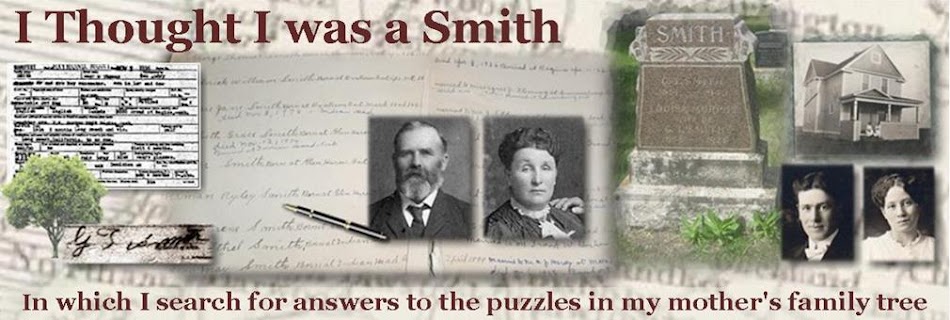Looking at George's siblings, and hunting for their living descendants, I realized that of the twelve children born to William and Prudence Cockram (George's parents), all of whom lived to at least early adulthood, only six of them had children of their own. I find that rather remarkable, considering the times they lived in - their childbearing years roughly spanned 1860-1915. Nevertheless, the six who did reproduce managed to have at least 37 children altogether, so there's no shortage of Cockram descendants.
And recently, I found four more of them - my 3rd cousins Helen, Lizzie, Karen and Simon. Their great-grandmother was Clara Cockram, George's youngest sister. I have a particular interest in Clara, as I have a feeling George was rather fond of her, and I had hopes that he corresponded with her from Canada, and told her why he changed his name. Helen has found several interesting documents among the family papers, but sadly, there are no letters from George among them.
But that doesn't curb my interest in Clara. I've been lucky enough to find pictures of most of the houses she lived in, as well as a few other significant places in her life, so I thought I'd make a map of them, just to see if Google's 'My Maps' application is really as easy to use as they say it is.
UPDATE: Two days after spending a ridiculous amount of time going through the tedious process of adding pictures to the map, I've discovered that almost all of them are now refusing to show up. So I've added some of them to this post instead. The most you can hope for from the map is that it will show you the locations of these places - don't count on anything else. Cross your fingers and click on the map for a larger, zoomable version, and if by some miracle you can see the photos, please let me know. And take my advice - don't ever bother trying to make a customised map with Google. Life's too short.
 |
| Amen Court, London, built as residences for the minor canons of St Pauls. |
I don't know when or where Clara met her future husband, Henry Moran - he was her first cousin, so they may have known each other since childhood - but Henry grew up in London, so that's not altogether likely. In 1891, at the age of 22, he was living at 80 Corporation Buildings in Clerkenwell, London, with his younger brother and sister. These were large apartment buildings built in 1865, intended for the poor, but they were quite well appointed for their time, complete with balconies and indoor toilets, and were inhabited by many working and middle class tenants. In 1894, Clara was living at the same address. Perhaps she had moved in as a flatmate with her three cousins, and a relationship with Henry grew from there.
 |
| Interior of St Etheldreda's Catholic Church |
 |
| 43 Hartham Road - the one on the right of this group of three |
They had four children - Etheldreda (at last I know where that name came from!), Evelyn, Francis and Stella. Henry died in 1927, and Clara stayed at the Hartham Road house, often sharing it with other people, including her daughter Evelyn, her widowed sister Lucy, and other people who I assume were lodgers. Etheldreda and her family lived a couple of bus rides away in North Finchley, and Clara had a close relationship with them. Francis and his family were nearby too. Stella had Down Syndrome and lived with her mother until about 1939 - from then on, she lived at Nazareth House, a care home not far away.
 |
| Nazareth House - a care home in Hammersmith, London, run by the Sisters of Nazareth |
When World War Two broke out, Clara was 75 years old. The 1939 Register, taken in September that year, shows her in Swanage, on the coast of Dorset. Many people left London around that time, because there was a general fear of London being bombed, and this may be why Clara left. On the other hand, her daughter Etheldreda's family had planned a holiday in Swanage in August 1939, which they cancelled, because Etheldreda's husband Henry Golton, a senior civil servant, had his leave cancelled due to preparations for war. Perhaps Clara had intended to join them on that holiday, and in the end, she went alone.
 |
| 17 Park Road, Swanage. This may have been a lodging house, or Clara might have been staying with friends. Below is the view from in front of the house, which is near the top of a steep hill. |
In any case, she was soon back home in London. Later on when London came under attack, a couple of houses in Hartham Road were destroyed, and Clara's house was damaged, but not so badly that she had to leave - in fact she was determined to stay put.
Clara saw the war out and carried on until 1950, when at the age of 86 she died of bronchopneumonia, at the French Hospital in Shaftesbury Avenue, London. She left her money, around £1200, to Evelyn and Francis, and I presume she left the house to Evelyn, who was still living there in 1953.
 |
| The French Hospital, Shaftesbury Ave, London. This building is now a hotel. |






